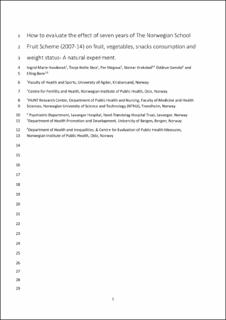| dc.contributor.author | Hovdenak, Ingrid Marie | |
| dc.contributor.author | Stea, Tonje Holte | |
| dc.contributor.author | Magnus, Per | |
| dc.contributor.author | Krokstad, Steinar | |
| dc.contributor.author | Samdal, Oddrun | |
| dc.contributor.author | Bere, Elling Tufte | |
| dc.date.accessioned | 2020-03-26T10:36:06Z | |
| dc.date.available | 2020-03-26T10:36:06Z | |
| dc.date.created | 2019-10-31T23:00:09Z | |
| dc.date.issued | 2019 | |
| dc.identifier.citation | Scandinavian Journal of Public Health. 2019, 1-11. | en_US |
| dc.identifier.issn | 1403-4948 | |
| dc.identifier.uri | https://hdl.handle.net/11250/2648835 | |
| dc.description.abstract | Aim: From August 2007 to June 2014, the Norwegian School Fruit Scheme (NSFS) legally established that all pupils in junior high and combined schools (275,000 pupils every year), but not those in primary schools (343,000 pupils every year), were entitled to a free piece of fruit or vegetable every school day. The NSFS is a natural experiment, unique in terms of scope and lengthiness. Such governmental efforts to improve the diet of the public are rarely evaluated. Thus, an evaluation of the comprehensive, well-designed NSFS is warranted. The aim was to describe how the NSFS can be evaluated using existing data sets. Methods: Four data sets have been identified for the evaluation of the NSFS: (a) the Nord-Trøndelag Health Study, (b) the Norwegian Mother and Child Cohort Study, (c) the Norwegian Child Growth Study/Growth in Teenagers and (d) Health Behaviour in School Aged Children. These comprehensive studies have collected cross-sectional or longitudinal data providing information about children’s dietary consumption and/or weight status, which can be utilised in the evaluation of the NSFS. Both short- and long-term effects of the NSFS related to dietary habits and weight status and the potential effect of moderators such as socio-economic status, sex, ethnicity and the age of children and adolescents can be studied. Conclusions: Worldwide, there is a lack of well-designed, long-term studies evaluating the impact of governmental efforts to improve public diet. The present study describes how the NSFS can be evaluated using data from four large data sets on eating habits and weight status. | en_US |
| dc.language.iso | eng | en_US |
| dc.publisher | Sage Publications | en_US |
| dc.title | How to evaluate the effect of seven years of The Norwegian School Fruit Scheme (2007-14) on fruit, vegetables, snacks consumption and weight status- A natural experiment. | en_US |
| dc.type | Peer reviewed | en_US |
| dc.type | Journal article | en_US |
| dc.description.version | acceptedVersion | en_US |
| dc.source.pagenumber | 1-11 | en_US |
| dc.source.journal | Scandinavian Journal of Public Health | en_US |
| dc.identifier.doi | 10.1177/1403494819875923 | |
| dc.identifier.cristin | 1743040 | |
| dc.relation.project | Norges forskningsråd: 262700 | en_US |
| dc.description.localcode | © 2019. This is the authors' accepted and refereed manuscript to the article. The final authenticated version is available online at: http://journals.sagepub.com/doi/10.1177/1403494819875923 | en_US |
| cristin.ispublished | true | |
| cristin.fulltext | postprint | |
| cristin.qualitycode | 1 | |
